Abstract
Shape-stable phase change materials (ss-PCMs) are extensively applied in renewable energy storage. The core for realizing high latent heat and good thermal stability of ss-PCMs is the designation of suitable supporting skeletons that can effectively preserve the PCMs from leaking out. In this study, ss-PCMs impregnated by D-mannitol were prepared using a waste yeast-derived carbon (YC) as the support material. YC possesses a large surface area (669.90 m2/g), which can provide sufficient phase transition space and nucleation sites for D-mannitol. The results indicated that a reduced supercooling of 44.76 °C for YC/D-mannitol ss-PCMs can be realized. The ss-PCMs also exhibited good cycling stability, with latent heat loss rates of 4.00% and 2.15% after 200 thermal cycles. We further demonstrate that YC provides restricted space for mannitol to inhibit the supercooling mechanism. The YC/D-mannitol ss-PCMs exhibited great promise for solar heat storage and industrial waste heat recovery in the medium temperature domain.
1. Introduction
Focusing on the challenges of global energy scarcity and continuously exploring sustainable ways to utilize solar energy are key to solving the energy crisis [1,2]. However, the temporal fluctuations and the unstable solar energy supplement hinder the large-scale application of the solar thermal technologies. This obstacle can be solved by adoption of thermal energy storage (TES) technologies, such as the sensible heat storage, thermochemical reactions, and the latent heat storage [3]. Among the candidate solutions, the latent heat storage (LHS) by phase change materials (PCMs) possesses high energy storage density and high latent heat, which can be maintained at almost constant temperature. Consequently, the use of PCMs has become the most popular TES technique to be investigated [4].
To date, various organic solid-liquid phase change materials including paraffin have been extensively utilized for LHS [5]. D-Mannitol is a natural sugar alcohol with advantages of high phase transition enthalpy, non-toxicity, non-corrosiveness, and low cost [6]. The solid-liquid phase transition temperatures of D-mannitol are between 165 °C and 174 °C. Therefore, it can be potentially used as a medium-temperature PCM for solar heat storage. One drawback, however, is the leakage problem, which might cause serious damage through device failure and contamination in realistic applications [7].
To solve the problem, the most effective method is the adoption of shape-stabilization phase change materials (ss-PCM), i.e., using a porous supporting matrix integrated with the organic PCMs as the working substance. In typical energy storage process by ss-PCM, the latent heat can be stored or released in the melting or solidifying processes, and the supporting matrix prevents the melted PCM from leaking out. The core to the superior TES performance by ss-PCM is the proper designation and management of the supporting material [8]. To date, various nanoparticles, polymers, and other porous materials that are rich in hierarchical pores have been explored as the PCM support (e.g., graphite [9], carbon nanotubes [10], porous aerogel [11], MOFs [12], and encapsulation by MgCO3 [13], and SiO2 [14], cellulose nanofibrils [15]); the macropores are favorable to PCM storage, the mesopores provide transport pathways, and the micropores offer capillary force.
Recently, PCM-supporting porous carbon materials that are derived from biomass have gained great interest due to their renewability and low cost. Organized hierarchical porous carbon skeletons could not only provide space for PCM encapsulation, but also provide an orderly thermal conductivity network. An et al. [16] used carbonized wood fiber as the porous support for erythritol and mannitol storage; the microporous structure of the carbon matrix enabled significant reduction of the degree of subcooling and increase of the thermal conductivity of the sugar alcohols as PCMs. In another work, Wei et al. [17] prepared a carbon aerogel from succulent plants; the abundant closed sponge-like tissues allowed a high loading rate of the organic PCM and significantly reduced liquid leakage. Liu et al. [18] prepared biomass-derived carbonaceous aerogel (BDCA)/D-mannitol ss-PCM. The porous structure in the BDCA support inhibited the supercooling of D-mannitol and improved the heat energy release.
Yeast is an ellipsoidal single-celled fungus widely found in nature. The yearly production of yeast cells and their derivatives reaches over 3 million tons/year [19]. Yeast cells are easy to cultivate, homogeneous in form, and exhibit a natural porous structure that is rich in functional groups [20]. In previous research, the spent yeast from bioethanol industry has been transformed into porous carbon by pyrolysis. Yeast-derived carbon (YC) can be used as electrocatalyst, adsorbent, and supercapacitor [21]. The stable skeleton and the unique porous structure of YC led us to consider using it as the support matrix for D-mannitol ss-PCM. In this study, for the first time, the YC/D-mannitol ss-PCM was prepared after yeast carbonization and vacuum impregnation. The phase transition behaviors and shape stability, as well as the cycling performances of the YC/D-mannitol ss-PCM, were fully characterized and investigated.
2. Materials and Methods
2.1. Materials
Wet yeast cells (Saccharomyces cerevisiae M 3013) were laboratory prepared by batch ethanol fermentation, according to the method described in the literature [22]. D-mannitol (98 wt%) and KOH (90 wt%) were obtained from Macklin Co., Ltd., Shanghai, China. Ethanol (98%, v/v) and H2O2 (30%, v/v) were purchased from Tianjin Fuchen Chemical Reagent Co., Ltd., Tianjin, China.
2.2. Carbonization of the Spent Yeast Cells
The YC as the supporting matrix of ss-PCM was prepared according to the protocol showed in Figure 1. First, the spent yeast cells were collected from the ethanol fermentation broth; they were then washed 3 times with ethanol and distilled water. Then, the wet spent yeast cells were mixed with 5% (w/v) of H2O2 solution under a dosage rate of 30%, followed by hydrothermal carbonization at 160 °C for 12 h in a 50 mL Teflon-lined stainless autoclave (20 mL of working volume). The solid fraction after hydrothermal carbonization was collected and was washed with deionized water, followed by drying out at 80 °C. Finally, the solid was heated with solid KOH at a mass ratio of 1:2 at 600 °C for 4 h, with a heating rate of 5 °C /min in a N2 flow (50 mL/min). After being washed and drying out, the solid product was separated as the YC skeleton for ss-PCM.

Figure 1.
Diagram for the preparation of YC/D-mannitol ss-PCM.
2.3. Synthesis of the YC/D-Mannitol ss-PCM
The YC/D-mannitol was prepared through vacuum-assisted impregnation. Generally, the YC skeleton was impregnated with the molten D-mannitol in a vacuum oven at 180 °C for 4 h, followed by cooling down to room temperature (~25 °C). Subsequently, aiming to remove the excess D-mannitol, the YC after D-mannitol loading was put on a copper filter and was inserted into an oven at 180 °C. The D-mannitol adsorption capacity (ω) of the ss-PCM can be calculated by the following equation:
where m1 is the weight of YC support, and m2 is the weight of YC/D-mannitol, ω is the molar ratio of mannitol in YC/mannitol.
2.4. Characterization
The surface morphology and the structure of YC/D-mannitol ss-PCM was observed by scanning electron microscopy (SEM, Hitachi, Tokyo, Japan, SU1510), and the elemental content was obtained by energy dispersive spectroscopy (EDS) in conjunction with SEM. The functional groups and chemical compatibility of the YC skeleton and YC/D-mannitol ss-PCM were evaluated by Fourier transform infrared spectroscopy (FTIR, Thermo Fisher Nicolet 6700, Waltham, MA, USA) in the wavenumber range of 4000–500/cm. X-ray diffraction (XRD) (Japan Rigaku, Tokyo, Japan, D/Max 2500 VB2 + PC) was used to analyze the crystalloid phase of the ss-PCM with a step size of 0.05° and a range from 5° to 80°. The chemical valence analysis of specimens was analyzed by X-ray photoelectron spectroscopy (XPS, Thermo Scientific K-Alpha, Waltham, MA, USA). The temperature and heat of the phase transition progress of the ss-PCM were measured by DSC from 50 °C to 180 °C in N2 atmosphere (Switzerland Mettler DSC 1, Greifensee, Switzerland). The heating rate was 5 °C /min. The thermal stability of the specimens was measured by TGA (Switzerland Mettler, TGA/DSC3+, Greifensee, Switzerland) for the temperature range from 30 °C to 600 °C, with 10 °C /min heating ramp in N2 atmosphere. The response of YC/D-mannitol to heat and the buffering effect were examined by an infrared thermography camera (FLIR T540). The specific surface area and pore size were characterized at 77 K (Micromeritics, Norcross, GA, USA, ASAP 2460) by the Brunauer–Emmett–Teller (BET) method.
3. Results
3.1. Morphology and Structure of the YC Skeleton
Figure 2a shows the SEM image of the YC skeleton obtained in the current work. Similar to other yeast-derived carbons in the literature [21], the macropores were observed on the surface of the YC skeleton after carbonization and activation. The YC is connected by holes with different pore sizes and has a relatively fluffy structure. Therefore, we speculated that the YC exhibited a large loading space for the adsorption of PCM. The EDS energy spectrum (Figure 2b) illustrated that the YC was mainly composed of C and O elements. The carbon content of YC was 66.27% and the oxygen content was 33.73%.
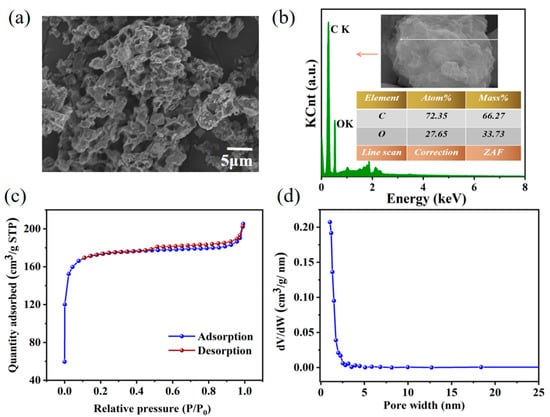
Figure 2.
(a) SEM image, (b) EDS spectra of YC skeleton for ss-PCM. (c) N2 adsorption-desorption isotherms, (d) BJH pore size distribution of the YC.
Pore structure is one of the important indexes to measure the loading capacity of an ss-PCM scaffold [12]. As is shown in Figure 2c, the YC was identified as a typical IV-type isotherm with a hysteresis loop from 0.5–1 P/P0, confirming that the YC was rich in mesoporous structure. Additionally, isotherms of YC grew sharply at low P/P0 values, reflecting the microporous structure in YC. The multi-sized pore structure of the YC skeleton would clearly provide suitable spaces for the phase transition of D-mannitol when used as the ss-PCM support. In addition, the capillary effect and surface tension of the YC would also provide suitable channels to preserve D-mannitol from leakage. According to the BET and BJH models [23], the YC has a large specific surface area of 669.90 m2/g, and the pore volume is 0.51 cm3/g (Figure 2d, Table 1). We speculated the large specific surface area and suitable pore size would exhibit large adsorption capacity and strong capillary force when using YC as the support of ss-PCM.

Table 1.
Pore structure parameters of YC.
3.2. Morphology and Structure of YC/D-Mannitol
The morphology and structure of the ss-PCM using YC as the carrier material was investigated. As seen from the SEM images (Figure 3a,b), the pores on the surface of the YC were almost completely filled with D-mannitol, attributed to the storage space provided by the carbonized skeleton. As seen from the EDS spectra (Figure 3c), the O-element content of ss-PCM was 43.54% higher than that of YC (33.73%), confirming that ss-PCM could effectively be impregnated with D-mannitol. This indicates that the YC skeleton promotes the adsorption of D-mannitol and the formation of ordered thermal storage units.

Figure 3.
(a,b) SEM images, (c) EDS spectra of the YC/D-mannitol ss-PCM.
In order to verify the interaction between YC support and D-mannitol, XRD diffraction of YC and ss-PCM was undertaken (Figure 4a). Two derived peaks at 25° and 43° belonged to the (002) plane and the (100) plane [24]. Therefore, the YC was rich in graphite microcrystals. The diffraction peaks were broad and weak, inferring a low degree of graphitization of the YC. The characteristic diffraction peaks of D-mannitol could be found at 2θ = 9.12°, 18.24°, 19.35° and 27.63° in the XRD patterns of YC/D-mannitol [25]. Due to a certain polymorphic transition of D-mannitol during the phase transition, a slight shift in the peak position was observed.
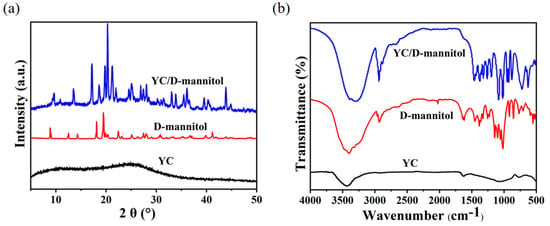
Figure 4.
(a) XRD pattern, (b) FTIR spectrum of YC, D-mannitol, YC/D-mannitol.
Figure 4b shows the FTIR spectrum of YC, D-mannitol and ss-PCM. The FTIR results implied that YC contains various functional groups; the peaks at 3455/cm and 1680/cm were the stretching vibration and bending vibration peaks of -OH [26], the peak at 1120/cm was the stretching vibration of C-O, and 730/cm was the oscillation vibration of -CH2 [27]. The variable angle vibration of the alcohol hydroxyl group at 1080/cm and the absorption peak of the a-type glycosidic bond at 700/cm were observed [28]. Moreover, these peaks were also detected in the spectrum of ss-PCM, indicating an effective physisorption in the YC backbone. We speculated that the intermolecular forces formed between the abundant functional groups on the surface of the YC scaffold and the -OH of D-mannitol could facilitate the adsorption of liquid D-mannitol onto YC [29]. The introduction of YC carriers significantly enhanced the absorption intensity due to the formation of heterogeneous structures and the promotion of D-mannitol crystals.
In order to clarify the chemical state of the elements on the surface of YC before and after D-mannitol impregnation, XPS energy spectroscopy was performed. The C and O atom peaks were observed in the XPS survey spectra (Figure 5a,d) [30], which was in accordance with the EDS results. We further fitted the high-resolution XPS spectra of C 1s (Figure 5b,e) and O 1 s (Figure 5c,f). The C-C, C-O and C=O bonds were identified from the C 1s spectra at specific binding energies of 284.8 eV, 286.5 eV, and 288.5 eV, respectively. At the same time, in the O 1s spectra, the O-C and O=C bonds were determined at 533.0 eV and 532.2 eV, respectively. It is clear that the photoelectron peak of O1s in ss-PCM is significantly stronger than that of YC. Therefore, the O element content in ss-PCM is higher than that of YC. Combined with the EDS results, it can be concluded that a large amount of D-mannitol was retained in ss-PCM by vacuum impregnation.
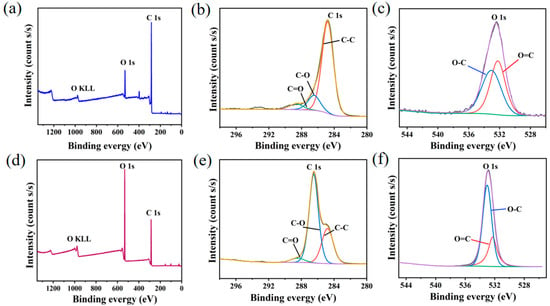
Figure 5.
High-resolution XPS spectra of YC (a–c) and YC/D-mannitol ss-PCM (d–f).
3.3. The Thermal Performance of the YC/D-Mannitol ss-PCM
High supercooling was long been considered as a critical bottleneck when considering D-mannitol as a medium temperature PCM. In order to reduce the supercooling, the common strategies were adding nucleating agents, making multiple eutectics, or micro-encapsulation [31]. Nonetheless, these strategies were suffered from latent heat reduction, leakage of PCM, and high costs. Fortunately, after mixing the YC skeleton with the D-mannitol, the latent heat of phase change and supercooling can be improved, owing to the porous structure of the supporting material.
In this section, the thermal performance of the YC/D-mannitol ss-PCM was further investigated. ΔT = Tm − Tc is the equation used to calculate the supercooling degree (ΔT) from melting temperature (Tm) and crystallization temperature (Tc). Previous research suggested D-mannitol exhibited a high degree of supercooling, which further resulted in a delaying of solidification [32]. According to the DSC curve (Figure 6a), pure D-mannitol had a Tm of 167.56 °C and Tc of 113.72 °C. Thus, the ΔT was as high as 53.84 °C. He [33] prepared mannitol emulsion particles to reduce the supercooling to 52.9 °C. Zeng [34] added 3% graphite to the m-Erythritol/D-mannitol binary system and the supercooling was reduced to 62.6 °C. Attractively, the YC/D-mannitol prepared in the present work possessed a supercooling of only 44.76 °C (with Tm of 165.23 °C and Tc of 120.47 °C) (Table 2), which was 16.86% lower than that of pure D-mannitol. The melting enthalpy (ΔHm, ss-PCM) and the crystallization enthalpy (ΔHc, ss-PCM) of YC/D-mannitol were 173.68 J/g and 132.37 J/g, respectively, closer to the calculated theoretical values (179.17 J/g and 141.64 J/g). Usually, owing to the inability of the carbon skeleton to phase change, a significant decrease in the molar latent heat of ss-PCM was observed. In this work, the latent heat of YC/D-mannitol of the same mass was reduced compared to pure D-mannitol. A brief comparison of the current advances of the ss-PCMs is shown in Table 3.
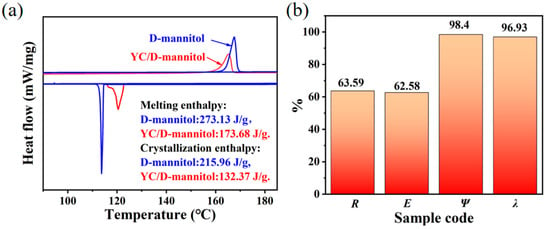
Figure 6.
(a) DSC curves and (b) the thermal characteristics of the YC/D-mannitol ss-PCM.

Table 2.
Enthalpy and phase change temperature of the YC/D-mannitol ss-PCM.

Table 3.
Current advances of the medium temperature ss-PCMs. The thermal performance values of the ss-PCMs are compared.
The attractive thermal performance of the YC/D-mannitol led us to further investigate the heat release capacity of the ss-PCM. The following equations were adopted to calculate the corresponding parameters [39].
where R is thermal storage capacity. ΔHm, ss-PCM and ΔHc, ss-PCM are the melting enthalpy and crystallization enthalpy of ss-PCM, respectively. ΔHm, Man and ΔHc, Man are the latent heat of D-mannitol in the melting and freezing processes, respectively. E represents the actual percentage of stored/released energy. Ψ is the impregnation efficiency, and λ expresses relative enthalpy efficiency capacity.
As shown in Figure 6b, the R reached 63.59%, while the ω of YC/D-mannitol was 65.60%, indicating the effective D-mannitol impregnation in the ss-PCM; almost all of the D-mannitol molecules were involved in the solid to liquid energy conversion. The E value (62.58%) proved that both the heat absorption and the exothermic processes were promoted in the ss-PCM. The Ψ value of YC/D-mannitol is 98.40%. Almost all of the D-mannitol molecular chains were embedded in the pores of the YC skeleton, enabling the phase change during the heat absorption and exothermic release. In addition, the adsorption force and nucleation sites provided by the YC supported efficient heat storage. The high specific surface area of YC provided enough phase transition space for D-mannitol molecules. In addition, the molecular chains were almost unconstrained during the phase transition process. Therefore, the D-mannitol could easily transfer from the amorphous phase to the crystalline phase. As a result, YC/D-mannitol has a high λ value (96.93%), high crystallinity, and a lower latent heat loss. The above results demonstrate that the YC carrier not only provides a suitable backbone for the preservation of D-mannitol, but also significantly improves the thermal properties of the ss-PCM.
3.4. The Stability of YC/D-Mannitol ss-PCM
Considering the possible applications, the stability of YC/D-mannitol was investigated. As presented in Figure 7a, the initial thermal decomposition temperature of the pure D-mannitol was 283.5 °C, which was lower than that of the YC/D-mannitol (292.2 °C). Both pure D-mannitol and YC/D-mannitol were degraded in one step, with 97.81% of pure D-mannitol weight degradation occurring in the range of 275 °C to 375 °C. In contrast, 71.53% weight loss of YC/D-mannitol was observed between temperatures of 283 °C and 387 °C. As is shown in the DTG thermograms (Figure 7b), the Tmax values of pure D-mannitol and YC/D-mannitol were 351.74 °C and 364.23 °C, respectively. Therefore, the introduction of YC support could significantly improve the thermally stability of the D-mannitol as PCM. This phenomenon can be attributed to the multi-level pore structure of YC, which could effectively delay the thermal decomposition of D-mannitol.
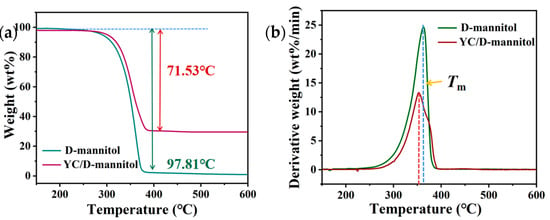
Figure 7.
(a) TGA and (b) DTG thermograms of the pure D-mannitol and the YC/D-mannitol ss-PCM.
Long-term operation of the charging/discharging cycles of the YC/D-mannitol was conducted, in order to investigate the stability of the ss-PCM. The structure and properties of the recycled ss-PCM after 200 cycles were almost unchanged. This statement is reflected in the XRD and FTIR spectra (Figure 8a,b). As shown in Figure 8c, the DSC curves of the ss-PCM at the 1st and 200th cycles almost overlapped. Here, we may introduce the melting coefficient (ηm) and crystallization coefficient (ηc) to quantify the stability of the ss-PCM:
where ΔHm,1 and ΔHm,200 represent the enthalpy of melting. The ΔHc,1 and ΔHc,200 represent the enthalpy of crystallization in the initial state and after 200 cycles of operation.

Figure 8.
(a) XRD, (b)FTIR, and (c) DSC curves of the YC/D-mannitol after 200 cycles.
After 200 cycles of heating charge and discharge, YC/D-mannitol had 4.00% ηm while ηc was 2.15%. The supercooling was only changed by 0.75 °C. Therefore, rapid energy release was also realized using the reused YC/D-mannitol (Table 4).

Table 4.
Thermal properties of the YC/D-mannitol before and after 200 cycles of charge and discharge.
3.5. Leakage Analysis
Leakage analysis was further conducted. Generally, in this process, the pure D-mannitol and ss-PCM were pressed into cylinders of 0.6 mm diameter and 0.2 mm height. The cylinder specimens were placed on a heating stage at 180 °C. The state of the specimens at different times was recorded by a digital camera (Figure 9). D-Mannitol gradually changes from solid to liquid and rapidly loses its shape, completely changing to a liquid state after 280 s of heating. The ss-PCM almost kept the original shape with only a trace amount of liquid leakage during the entire heating process. This was attributed to the molecular force provided by the YC skeleton.
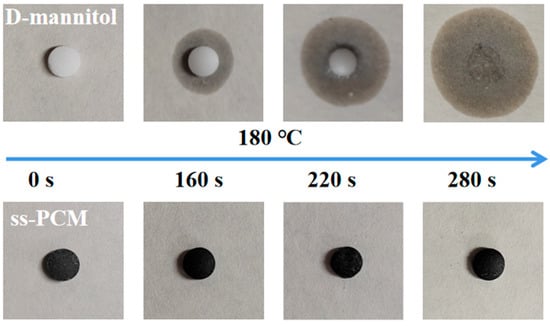
Figure 9.
The optical images of the pure D-mannitol and the YC/D-mannitol ss-PCM on a heating stage.
3.6. Thermal Response of the YC/D-Mannitol ss-PCM
In order to visualize the thermal response behavior of the YC/D-mannitol, a homemade thermal infrared imaging platform was used (Figure 10a). During the heating process, samples were placed on the platform, and thermal infrared photographs were taken in the center of the specimens. As can be seen from Figure 10b, from the initial temperature, YC/D-mannitol and D-mannitol have to be heated for 160 s and 206 s before phase transition (the phase transition temperature was between 138 °C and 172 °C), and the phase transition temperature interval coincides with the DSC results. It took 770 s and 890 s for YC/D-mannitol and D-mannitol to cool down from the melted state to the initial state, respectively, and the heat storage and exothermic rates of YC/D-mannitol were significantly higher than those of D-mannitol. Therefore, YC could assist D-mannitol in rapid heat transfer. Through the record of the thermal infrared camera (Figure 10c), the YC/D-mannitol could be seen to exhibit good thermal responses.
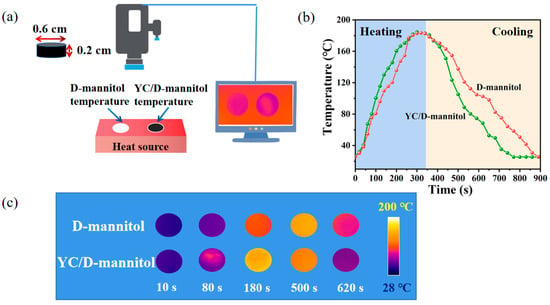
Figure 10.
(a) Schematic illustration of the thermal response test, (b) plots of the temperature evolution, and (c) thermal infrared camera images of the YC/D-mannitol during the heat recovery process.
4. Conclusions
A novel medium temperature ss-PCM was developed by vacuum impregnation of D-mannitol into the YC carrier. YC is a renewable biomass-based skeleton that was obtained by carbonizing waste yeast. The melting enthalpy and crystallization enthalpy of YC/D-mannitol reached 173.68 J/g and 132.37 J/g, respectively, and the energy storage capacity reached 98.4%. The anisotropic nucleation provided by the carrier reduced the D-mannitol supercooling to 44.76 °C. After 200 cycles, the enthalpy of crystallization of ss-PCM was only decreased by 1.8%, indicating that the YC is suitable for long-term thermal storage. This study proposed a promising way for the preparation of hierarchical porous carbonized support from the waste streams in industry, and also provided new ideas for the use of sustainable medium temperature ss-PCM.
Author Contributions
X.L.: Writing, Formal analysis, Visualization, Methodology, Conceptualization; H.C.: Supervision, Synthesis, Representation; G.L.: Editing and Assistance; M.Z.: Raw material supply and Synthesis; W.J.: Formal analysis; K.W.: Raw material supply and Assistance; C.Z.: Editing and Synthesis; C.S.: Editing and Assistance; W.R.: Supervision and Data curation; D.C.: Investigation, Review and Editing, Funding acquisition. All authors have read and agreed to the published version of the manuscript.
Funding
This work is financially supported by the Bingtuan Science and Tecnology Program (Grant No. 2022DB025), and the Key Research and Development Program of Hebei Province (Grant No. 21327316D).
Institutional Review Board Statement
Not applicable.
Informed Consent Statement
All authors agree to publish.
Data Availability Statement
Data are contained within the article.
Conflicts of Interest
The authors declare no conflict of interest.
References
- Tao, Y.; He, Y.-L. A review of phase change material and performance enhancement method for latent heat storage system. Renew. Sustain. Energy Rev. 2018, 93, 245–259. [Google Scholar] [CrossRef]
- Alazwari, M.A.; Abu-Hamdeh, N.H.; Khoshaim, A.; Almitani, K.H.; Karimipour, A. Using phase change material as an energy-efficient technique to reduce energy demand in air handling unit integrated with absorption chiller and recovery unit—Applicable for high solar-irradiance regions. J. Energy Storage 2021, 42, 103080. [Google Scholar] [CrossRef]
- Sikiru, S.; Oladosu, T.L.; Amosa, T.I.; Kolawole, S.Y.; Soleimani, H. Recent advances and impact of phase change materials on solar energy: A comprehensive review. J. Energy Storage 2022, 53, 105200. [Google Scholar] [CrossRef]
- Liu, W.; Bie, Y.; Xu, T.; Cichon, A.; Królczyk, G.; Li, Z. Heat transfer enhancement of latent heat thermal energy storage in solar heating system: A state-of-the-art review. J. Energy Storage 2022, 46, 103727. [Google Scholar] [CrossRef]
- Li, Y.; Li, C.; Lin, N.; Xie, B.; Zhang, D.; Chen, J. Review on tailored phase change behavior of hydrated salt as phase change materials for energy storage. Mater. Today Energy 2021, 22, 100866. [Google Scholar] [CrossRef]
- Tomassetti, S.; Aquilanti, A.; Muciaccia, P.F.; Coccia, G.; Mankel, C.; Koenders, E.A.; Di Nicola, G. A review on thermophysical properties and thermal stability of sugar alcohols as phase change materials. J. Energy Storage 2022, 55, 105456. [Google Scholar] [CrossRef]
- Mo, S.; Shan, S.; He, L.; Jia, L.; Chen, Y. Nanoencapsulation of Binary Sugar Alcohols at Neutral pH Conditions. J. Clust. Sci. 2022, 34, 547–556. [Google Scholar] [CrossRef]
- Li, A.; Wang, J.; Dong, C.; Dong, W.; Atinafu, D.G.; Chen, X.; Gao, H.; Wang, G. Core-sheath structural carbon materials for integrated enhancement of thermal conductivity and capacity. Appl. Energy 2018, 217, 369–376. [Google Scholar] [CrossRef]
- Zhang, H.; Cheng, J.; Wang, Q.; Xiong, D.; Song, J.; Tang, Z.; Liu, X. The graphite foam/erythritol composites with ultrahigh thermal conductivity for medium temperature applications. Sol. Energy Mater. Sol. Cells 2021, 230, 111135. [Google Scholar] [CrossRef]
- Hussain, S.; Mottahir Alam, M.; Imran, M.; Zouli, N.; Aziz, A.; Irshad, K.; Haider, M.; Khan, A. Fe3O4 nanoparticles decorated multi-walled carbon nanotubes based magnetic nanofluid for heat transfer application. Mater. Lett. 2020, 274, 128043. [Google Scholar] [CrossRef]
- Zhou, M.; Xie, D.; Zhou, K.; Gong, K.; Yin, L.; Qian, X.; Shi, C. 3D porous aerogel based-phase change materials with excellent flame retardancy and shape stability for both thermal and light energy storage. Sol. Energy Mater. Sol. Cells 2022, 236, 111537. [Google Scholar] [CrossRef]
- Tang, J.; Yang, M.; Dong, W.; Yang, M.; Zhang, H.; Fan, S.; Wang, J.; Tan, L.; Wang, G. Highly porous carbons derived from MOFs for shape-stabilized phase change materials with high storage capacity and thermal conductivity. RSC Adv. 2016, 6, 40106–40114. [Google Scholar] [CrossRef]
- Zahir, M.H.; Irshad, K.; Aziz, M.A.; Shafiullah, M.; Rahman, M.M.; Hossain, M.M. Shape-Stabilized Phase Change Material for Solar Thermal Energy Storage: CaO Containing MgCO3 Mixed with Polyethylene Glycol. Energy Fuels 2019, 33, 12041–12051. [Google Scholar] [CrossRef]
- Zahir, M.H.; Rahman, M.M.; Irshad, K.; Shaikh, M.N.; Helal, A.; Aziz, M.A.; Ali, A.; Khan, F. Energy Conversion Efficiency Enhancement of Polyethylene Glycol and a SiO2 Composite Doped with Ni, Co, Zn, and Sc Oxides. ACS Omega 2022, 7, 22657–22670. [Google Scholar] [CrossRef]
- Bahsi Kaya, G.; Kim, Y.; Callahan, K.; Kundu, S. Microencapsulated phase change material via Pickering emulsion stabilized by cellulose nanofibrils for thermal energy storage. Carbohydr. Polym. 2022, 276, 118745. [Google Scholar] [CrossRef]
- An, J.; Liang, W.; Mu, P.; Wang, C.; Chen, T.; Zhu, Z.; Sun, H.; Li, A. Novel sugar alcohol/carbonized kapok fiber composites as form-stable phase-change materials with exceptionally high latent heat for thermal energy storage. ACS Omega 2019, 4, 4848–4855. [Google Scholar] [CrossRef]
- Wei, Y.; Li, J.; Sun, F.; Wu, J.; Zhao, L. Leakage-proof phase change composites supported by biomass carbon aerogels from succulents. Green Chem. 2018, 20, 1858–1865. [Google Scholar] [CrossRef]
- Liu, H.; Qian, Z.; Wang, Q.; Wu, D.; Wang, X. Development of Renewable Biomass-Derived Carbonaceous Aerogel/Mannitol Phase-Change Composites for High Thermal-Energy-Release Efficiency and Shape Stabilization. ACS Appl. Energy Mater. 2021, 4, 1714–1730. [Google Scholar] [CrossRef]
- Du, J.; Zhang, Y.; Lv, H.; Hou, S.; Chen, A. Yeasts-derived nitrogen-doped porous carbon microcapsule prepared by silica-confined activation for supercapacitor. J. Colloid Interface Sci. 2021, 601, 467–473. [Google Scholar] [CrossRef]
- Liu, J.; Huang, Y.; Zhao, Z.; Ren, W.; Li, Z.; Zou, C.; Zhao, L.; Tang, Z.; Li, X.; Wang, M. Yeast Template-Derived Multielectron Reaction NASICON Structure Na3MnTi (PO4)3 for High-Performance Sodium-Ion Batteries. ACS Appl. Mater. Interfaces 2021, 13, 58585–58595. [Google Scholar] [CrossRef]
- Tian, Y.; Ren, Q.; Chen, X.; Li, L.; Lan, X. Yeast-Based Porous Carbon with Superior Electrochemical Properties. ACS Omega 2021, 7, 654–660. [Google Scholar] [CrossRef] [PubMed]
- Zhang, C.; Wen, H.; Chen, C.; Cai, D.; Fu, C.; Li, P.; Qin, P.; Tan, T. Simultaneous saccharification and juice co-fermentation for high-titer ethanol production using sweet sorghum stalk. Renew. Energy 2019, 134, 44–53. [Google Scholar] [CrossRef]
- Mei, D.; Zhang, B.; Liu, R.; Zhang, Y.; Liu, J. Preparation of capric acid/halloysite nanotube composite as form-stable phase change material for thermal energy storage. Sol. Energy Mater. Sol. Cells 2011, 95, 2772–2777. [Google Scholar] [CrossRef]
- Zhao, Y.; Min, X.; Huang, Z.; Liu, Y.; Wu, X.; Fang, M. Honeycomb-like structured biological porous carbon encapsulating PEG: A shape-stable phase change material with enhanced thermal conductivity for thermal energy storage. Energy Build. 2018, 158, 1049–1062. [Google Scholar] [CrossRef]
- Wu, C.-B.; Wu, G.; Yang, X.; Liu, Y.-J.; Gao, C.-X.; Ji, Q.-H.; Wang, M.; Chen, H.-Z. Preparation of Mannitol@ Silica core–shell capsules via an interfacial polymerization process from water-in-oil emulsion. Colloids Surf. A Physicochem. Eng. Asp. 2014, 457, 487–494. [Google Scholar] [CrossRef]
- Zuo, X.; Li, J.; Zhao, X.; Yang, H.; Chen, D. Emerging paraffin/carbon-coated nanoscroll composite phase change material for thermal energy storage. Renew. Energy 2020, 152, 579–589. [Google Scholar]
- Li, C.; Xie, B.; Chen, J.; Chen, Z.; Sun, X.; Gibb, S.W. H2O2-microwave treated graphite stabilized stearic acid as a composite phase change material for thermal energy storage. RSC Adv. 2017, 7, 52486–52495. [Google Scholar] [CrossRef]
- Atinafu, D.G.; Dong, W.; Wang, J.; Huang, X.; Wang, J.; Gao, H.; Wang, G. Synthesis and characterization of paraffin/metal organic gel derived porous carbon/boron nitride composite phase change materials for thermal energy storage. Eur. J. Inorg. Chem. 2018, 2018, 5167–5175. [Google Scholar] [CrossRef]
- Feng, N.; Kang, Z.; Hu, D. Shape-stabilized and antibacterial composite phase change materials based on wood-based cellulose micro-framework, erythritol-urea or erythritol-thiourea for thermal energy storage. Sol. Energy 2021, 223, 19–32. [Google Scholar] [CrossRef]
- Mukhopadhyay, S.M.; Pulikollu, R.V.; Roy, A. Surface modification of a microcellular porous solid: Carbon foam. Appl. Surf. Sci. 2004, 225, 223–228. [Google Scholar] [CrossRef]
- Wang, T.; Liu, Y.; Meng, R.; Zhang, M. Thermal performance of galactitol/mannitol eutectic mixture/expanded graphite composite as phase change material for thermal energy harvesting. J. Energy Storage 2021, 34, 101997. [Google Scholar] [CrossRef]
- Salyan, S.; Suresh, S. Multi-walled carbon nanotube laden with D-Mannitol as phase change material: Characterization and experimental investigation. Adv. Powder Technol. 2018, 29, 3183–3191. [Google Scholar] [CrossRef]
- He, L.; Mo, S.; Lin, P.; Jia, L.; Chen, Y.; Cheng, Z. Synthesis and properties of nanoencapsulated D-mannitol for medium temperature thermal energy storage. Sol. Energy Mater. Sol. Cells 2020, 209, 110473. [Google Scholar] [CrossRef]
- Zeng, J.-L.; Chen, Y.-H.; Shu, L.; Yu, L.-P.; Zhu, L.; Song, L.-B.; Cao, Z.; Sun, L.-X. Preparation and thermal properties of exfoliated graphite/erythritol/mannitol eutectic composite as form-stable phase change material for thermal energy storage. Sol. Energy Mater. Sol. Cells 2018, 178, 84–90. [Google Scholar] [CrossRef]
- Huang, Z.; Luo, Z.; Gao, X.; Fang, X.; Fang, Y.; Zhang, Z. Investigations on the thermal stability, long-term reliability of LiNO3/KCl–expanded graphite composite as industrial waste heat storage material and its corrosion properties with metals. Appl. Energy 2017, 188, 521–528. [Google Scholar] [CrossRef]
- Kenisarin, M.M. High-temperature phase change materials for thermal energy storage. Renew. Sustain. Energy Rev. 2010, 14, 955–970. [Google Scholar] [CrossRef]
- Ren, Y.; Xu, C.; Yuan, M.; Ye, F.; Ju, X.; Du, X. Ca (NO3)2-NaNO3/expanded graphite composite as a novel shape-stable phase change material for mid-to high-temperature thermal energy storage. Energy Convers. Manag. 2018, 163, 50–58. [Google Scholar] [CrossRef]
- Pollerberg, C.; Kauffeld, M.; Oezcan, T.; Koffler, M.; Hanu, L.G.; Doetsch, C. Latent heat and cold storage in a solar-driven steam jet ejector chiller plant. Energy Procedia 2012, 30, 957–966. [Google Scholar] [CrossRef]
- Zahir, M.H.; Rahman, M.M.; Basamad, S.K.S.; Mohaisen, K.O.; Irshad, K.; Rahman, M.M.; Aziz, M.A.; Ali, A.; Hossain, M.M. Preparation of a Sustainable Shape-Stabilized Phase Change Material for Thermal Energy Storage Based on Mg2+-Doped CaCO3/PEG Composites. Nanomaterials 2021, 11, 1639. [Google Scholar] [CrossRef]
Disclaimer/Publisher’s Note: The statements, opinions and data contained in all publications are solely those of the individual author(s) and contributor(s) and not of MDPI and/or the editor(s). MDPI and/or the editor(s) disclaim responsibility for any injury to people or property resulting from any ideas, methods, instructions or products referred to in the content. |
© 2023 by the authors. Licensee MDPI, Basel, Switzerland. This article is an open access article distributed under the terms and conditions of the Creative Commons Attribution (CC BY) license (https://creativecommons.org/licenses/by/4.0/).